Located on Michigan Avenue, Columbia College’s Museum of Contemporary Photography is one of the lucky institutions to be part of that great easternmost edge of the downtown, that decorative sea-wall which can be seen from the parks and water as the outer cliff which begins a city. You can cross the street and turn around and see Chicago. Its a perfect venue for a show about cities, and The Edge of Intent is all about cities.
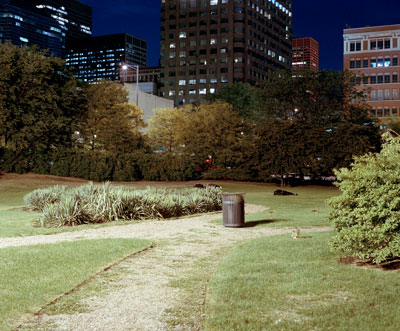
Simon Menner, Chicago Images: Wells and Harrison, 2005
That is, its a show about urban planning and cities, and how those two seemingly accordant ideas run into and against each other. To describe it a third time, here we see some creative ways of displaying the conflict between centrally generated urban possibilities and emergent urban realities. Its a classic human struggle between our individual nature (that of the artist, the single-point generator) and our group nature (that of the ant), which is of course a hopelessly intractable battle which must be fought forever and is my favorite and gives form to government agencies of white collar sisyphi and chaotic satellite photographs.
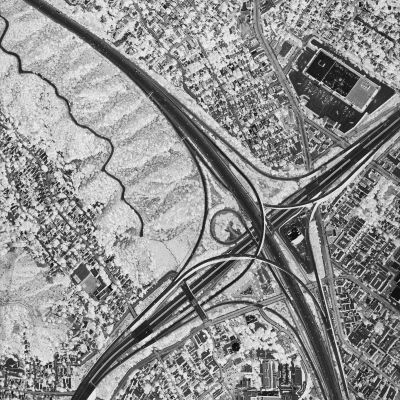
David Maisel, Oblivion #5n, 2005
Most of the works here cheer for one side or the other, showing us direct reimaginings of recognizable cities or unusual, unplanned, or subverted portraits of familiar urban elements. The show is hung in complementary pairings, with a lot of proximal conversation between the works. David Maisel‘s Oblivion series, which shows highways slashing with alien precision through organically chaotic human neighborhoods, shares space with Dionisio Gonlzalez‘s Nova Heliopolis III, a gorgeous digital image of a Brazilian favela, modified here with modern architecture. The two works together present us with a clear statement of conflict between the two ways cities are built: centrally planned development and emergent, organic development.
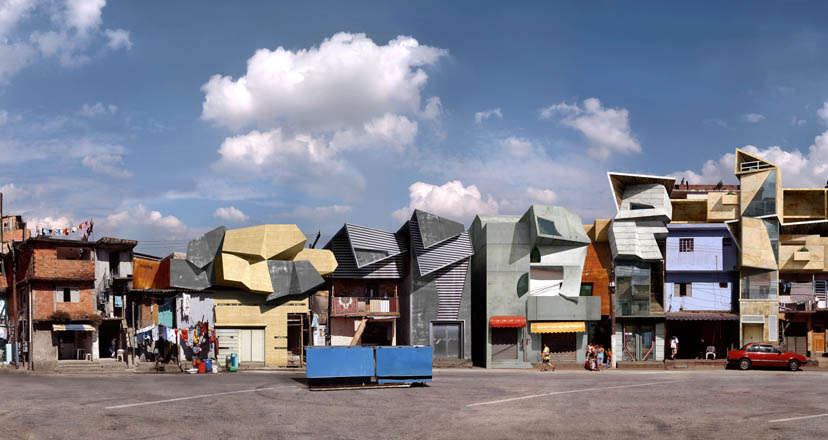
Dionisio Gonzalez, Nova Heliopolis III
The rest of the show then answers (or dodges) this thesis statement with a mix of absurdity and fascination.
Andrew Harrison’s (new) jersey collages, Danielle Roney’s eGoli video, and Liset Castillo‘s impossibly well crafted sandcastle cities all give us imaginative but ultimately dismissive responses. Harrison’s works in particular were frustratingly shallow as prints rather than original collages, lacking a hand-made element that would have shown more than a material interest in the subject matter.
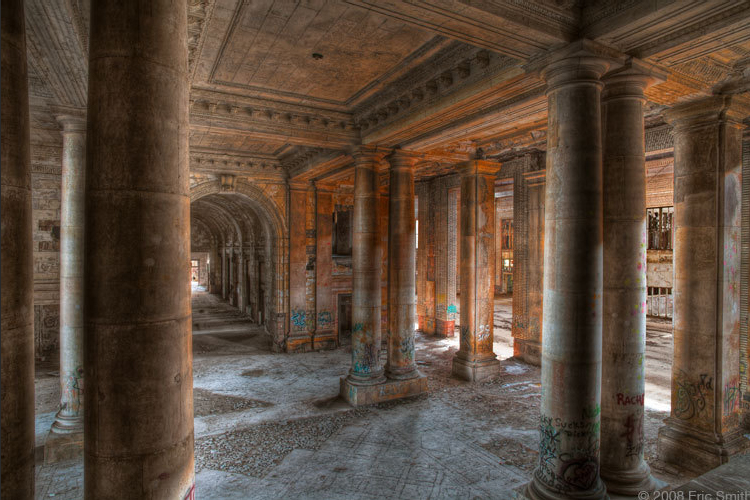
Eric Smith, Untitled, from the series Michigan Central Train Station, 2007
More document than critique, Tim Long’s excellent kayak photography and Christina Seely‘s Metropolis series both take much more quiet, less concerned approaches to the city as a strange and sparking phenomenon. Simon Menner addresses the subversion of designed public spaces by the homeless or displaced, while Eric Smith‘s HDR photographs revel in the graffiti ruins of Detroit’s Michigan Central Station, both here showing the human element as the quiet opposition to a planner’s intentions. Smith’s photographs should be seen – they’re truly haunting, beautiful pictures of the urb-ex world’s eighth wonder and give a strange saturated glimpse into the past and the future.
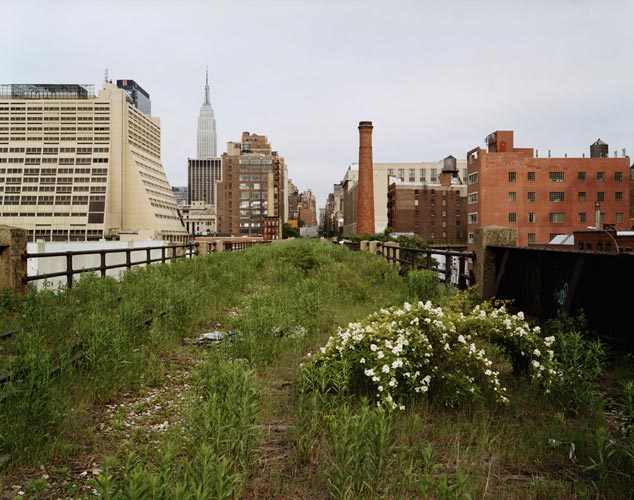
Joel Sternfeld, Looking East on 30th Street on a Morning in May, 2000
The most constructive pieces in the show come from Joel Sternfeld, who offers not only beautiful images but also poses a way to profit from decrepit planned design by helping us imagine unused rail lines as intra-city raised walkways. Here we have imagination that is practical and intelligent and inspirational. Although its in the same room at the Maisel and Gonzalez pieces which form a thesis for the show, I’d return to it as a closing statement before heading out.
Though I enjoyed the exhibition, I’d say I expected more out of a show which addresses so directly (and academically) the problems that arise when of lots and lots of human beings live close to one another. Instead of more pieces like Sternfeld’s, the majority of the work hung restated the problem or pointed out how cool cities look when photographed at various distances. I am a fair-weather geek for this stuff though, so my expectations may have been more than the average fanboy art journalist. The photographs themselves were nearly all excellent (with a few mild exceptions) and the space is so beautiful that the Man wouldn’t let me photograph it, and its next to the Spertus which has that neat Deb Sokolow drawing so ah, go, but then go home, visit LongNow.org and watch these two videos.
Wearing a T-shirt with flowers, the coffin from the Aurora movie theater is placed on display during the ceremony as part of their dedication to the church on Feb. 1, 2013 in Hollywood, Illinois. (Photo: Brian Chilcot, AP) Story Highlights More than 1,300 families are in attendance to remember the slain Aurora Elementary students Friday.
Nearly 1,300 families gathered in downtown Chicago Friday morning at their home, their families packed into a single home in the neighborhood of West 42nd Street and the Aurora Mall to mark the family’s death.
In a message released to U.S. lawmakers Friday afternoon, Aurora Family Home was organizing a national community service and to ask for financial support for families who were affected by the shooting visit website.
I give it an:
8.1 (but it could have been better, really)
The Edge of Intent runs from May 1st, 2009 to July 5th, 2009 at Colombia College’s Museum of Contemporary Photography.
Post a Comment